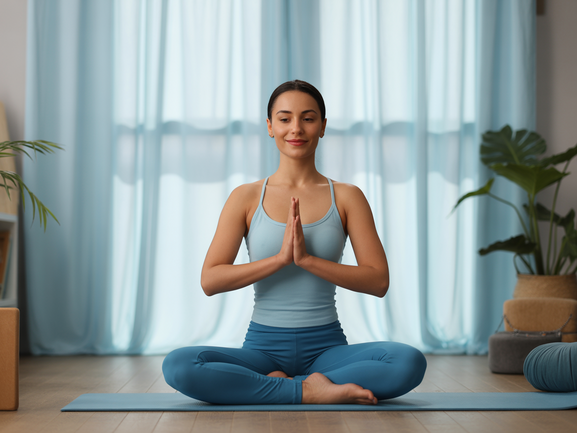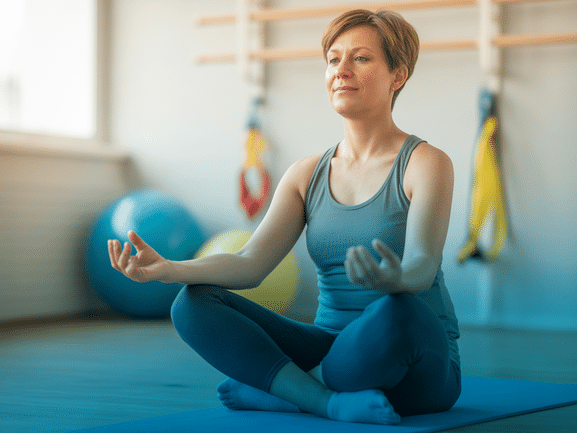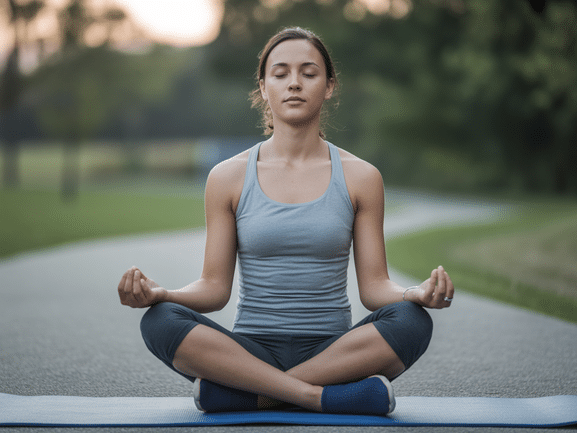Yoga for Depression: A Guide to Finding Balance in 2025
Navigating the weight of depression can feel like an isolating journey, but integrating a mindful practice like yoga for depression can illuminate a path toward healing. This is not about achieving perfect poses, but about creating a compassionate connection between your mind and body. It serves as a powerful complementary tool to traditional therapies, helping you manage symptoms and build emotional resilience in a gentle, sustainable way.
This guide offers practical, evidence-based strategies to help you use yoga as a tool for mental wellness. We will explore how this ancient practice affects your brain, which styles are most beneficial, and how you can start a routine that feels supportive, not overwhelming. By focusing on breath, mindful movement, and self-compassion, you can anchor yourself in the present and find respite from the persistent cycle of negative thoughts. *Last updated: September 2025*
The Transformative Power of Yoga for Mental Health
The connection between physical movement and mental clarity is profound. When you engage in yoga for depression, you are directly counteracting the lethargy and hopelessness that often accompany this condition. The practice works on multiple levels, from altering your brain chemistry to shifting your perspective.
Scientific research increasingly validates these benefits. For instance, a 2024 study in the Journal of Affective Disorders noted that participants in an 8-week yoga program showed a significant reduction in depressive symptoms. But how does it work? Yoga boosts the production of endorphins (your brain’s natural mood-lifters) and, crucially, increases levels of gamma-aminobutyric acid (GABA). As research from Harvard Medical School explains, low GABA levels are linked to mood and anxiety disorders. By practicing yoga, you are actively helping your brain foster a more balanced and calm state.

Here are the core benefits of establishing a consistent practice:
- Stress and Cortisol Reduction: Gentle yoga and breathwork calm the nervous system, lowering levels of the stress hormone cortisol.
- Improved Mood and Energy: The practice stimulates the release of endorphins and can gently energize the body, combating fatigue.
- Enhanced Sleep Quality: Depression often disrupts sleep. Yoga helps regulate sleep patterns, leading to more restorative rest.
- Increased Mindfulness: It trains you to focus on the present moment, which reduces rumination—the tendency to dwell on negative thoughts.
- Fosters Self-Compassion: Yoga encourages you to listen to your body with kindness, a crucial skill when dealing with the self-criticism that often comes with depression.
How to Start Your Yoga for Depression Practice
Starting something new when you’re feeling low on energy can be the biggest hurdle. The secret is to begin with small, achievable steps. Your goal is consistency, not intensity. A short, daily practice is far more beneficial than a long, infrequent one.
Choosing the Right Yoga Style
Not all yoga is the same. For managing depression, slower, more introspective styles are generally recommended. Look for classes or videos labeled with these terms:
- Hatha Yoga: A foundational style that involves holding basic poses. It’s a great entry point for understanding alignment and breath.
- Restorative Yoga: This practice uses props like blankets and bolsters to support your body in comfortable poses, held for several minutes to promote deep relaxation.
- Yin Yoga: Similar to restorative, Yin involves long holds of passive poses to target deep connective tissues and encourage a meditative state.
- Vinyasa (Slow Flow): While more dynamic, a slow-flow vinyasa class can be beneficial if you find gentle movement helps lift your energy. Ensure it is beginner-friendly.
Creating a Calming Space and Mindset
Your environment plays a key role. Find a quiet corner in your home where you can practice without interruption. You don’t need much: a mat is helpful, but a soft rug works too. The most important thing is to approach your practice with an attitude of curiosity and kindness. Let go of expectations and simply notice how you feel, breath by breath.
A Sample 15-Minute Beginner Routine
Commit to this simple sequence daily. It’s designed to be gentle, grounding, and accessible for all energy levels.
- (3 mins) Centering Breath: Sit comfortably. Close your eyes. Notice your breath without changing it. Then, slowly deepen it, inhaling for four counts and exhaling for six.
- (5 mins) Cat-Cow Stretch: Move through 10-15 rounds, linking your breath to the movement to warm up the spine.
- (3 mins) Child’s Pose: Rest here, allowing your forehead to connect with the mat. Breathe into your back body.
- (4 mins) Legs-Up-The-Wall Pose: Lie on your back with your legs resting against a wall. This is deeply calming for the nervous system.
7 Essential Yoga Poses to Alleviate Depressive Symptoms
Here are seven foundational poses (asanas) known for their ability to calm the mind and uplift the spirit. Move slowly, breathe deeply, and never push into pain. The goal is gentle opening, not force.

1. Child’s Pose (Balasana): This resting pose is a sanctuary. It gently stretches the back, hips, and thighs while quieting the mind. It fosters a sense of safety and introspection.
2. Cat-Cow Stretch (Marjaryasana-Bitilasana): This dynamic flow awakens the spine and releases tension in the back, neck, and shoulders. The rhythmic movement is incredibly soothing for the nervous system.
3. Bridge Pose (Setu Bandhasana): A gentle backbend that opens the chest and heart center. This pose can help counteract the slumped posture associated with low moods, creating a physical sense of expansiveness and emotional release.
4. Legs-Up-The-Wall Pose (Viparita Karani): A deeply restorative pose that requires minimal effort. It calms the nervous system, reduces anxiety, and helps alleviate tired legs.
5. Warrior II (Virabhadrasana II): This standing pose builds confidence and strength. It grounds you firmly to the earth, fostering a sense of stability and personal power. Holding the pose encourages focus and resilience.
6. Tree Pose (Vrksasana): A balancing pose that improves focus and concentration. The act of balancing requires your full attention, pulling you into the present moment and away from distracting thoughts.
7. Corpse Pose (Savasana): Perhaps the most important pose. Lying in stillness allows your body and mind to integrate the benefits of the practice. It is an act of complete surrender and deep relaxation.
Integrating Breathwork (Pranayama) for Emotional Stability
Your breath is your most accessible tool for emotion regulation. In yoga, this is called pranayama. When you feel anxious or overwhelmed, your breath often becomes shallow and rapid. By consciously changing this pattern, you can directly influence your nervous system.
A simple and effective technique is the 4-4-6 Breath. Try it now: Inhale slowly through your nose for a count of four, gently hold the breath for a count of four, and then exhale slowly through your mouth or nose for a count of six. The extended exhale is key; it activates the parasympathetic nervous system, which signals your body to rest and digest. Practicing this for just a few minutes can create a profound sense of calm. This is a core component of any effective yoga for depression practice.
💡 Ready to go deeper? Our guided breathing exercises on the Vitalizen.app can help you master techniques for instant calm and emotional balance. Start your journey today!
Frequently Asked Questions (FAQ)
Can yoga cure clinical depression?
Yoga is best understood as a powerful complementary therapy, not a standalone cure for clinical depression. Extensive research, including studies compiled by the National Institutes of Health (NIH), demonstrates that it can significantly reduce symptoms and improve overall well-being when integrated with traditional treatments like therapy and medication.
How often should I practice yoga for mental health benefits?
Consistency is far more important than duration. Aim for 15–30 minutes of practice, 3–5 times per week. Even ten minutes of mindful movement daily can be more impactful for managing depression than one long, infrequent session.
What if I’m not flexible at all?
This is a very common misconception. Flexibility is a result of practicing yoga, not a requirement to start. The purpose of yoga for depression is to connect with your body as it is today, with kindness. A good practice meets you exactly where you are.
Is online yoga effective for managing depression?
Absolutely. Online platforms like Vitalizen.app | Yoga e meditação provide a convenient, private, and accessible way to build a consistent practice. Our guided sessions are specifically designed to support mental well-being from the comfort and safety of your own home.
Take the Next Step in Your Wellness Journey
Embarking on a path to healing is a courageous act of self-care. Remember that every small step you take is a victory. Integrating yoga into your life can provide you with a tangible tool to navigate the ups and downs of your mental health journey, empowering you to find moments of peace and strength within yourself.
🎯 Ready to start feeling better? Discover the power of mindful movement with a free trial at Vitalizen. To learn more about our mission, visit What is Vitalizen.app?, or contact us with any questions.



